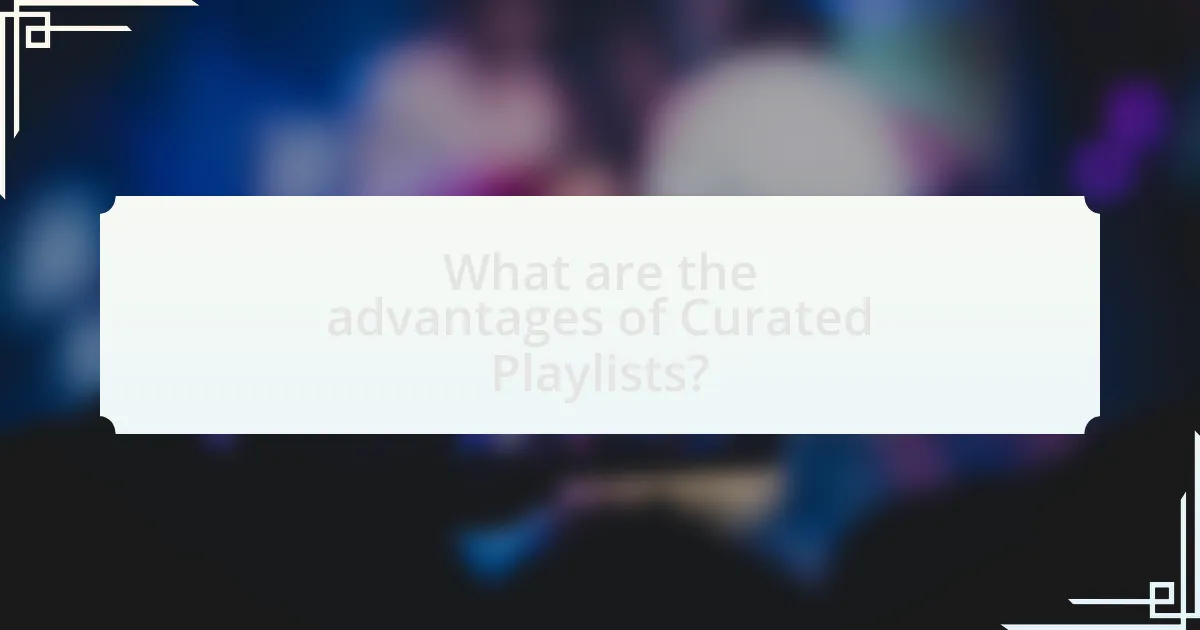Curated and algorithmic playlists are two distinct methods of music selection that impact user discovery on streaming platforms. Curated playlists are crafted by human editors who select songs based on themes, moods, and cultural relevance, while algorithmic playlists utilize data-driven algorithms to analyze user behavior and preferences for personalized recommendations. The article explores the differences between these two approaches, detailing the criteria used in curated playlists, the algorithms that drive algorithmic playlists, and the advantages and limitations of each method. It also discusses how users can effectively leverage both types of playlists to enhance their music discovery experience.

What are Curated and Algorithmic Playlists?
Curated playlists are collections of songs selected by human editors based on themes, moods, or specific genres, while algorithmic playlists are generated by algorithms that analyze user behavior, preferences, and listening history to create personalized music recommendations. Curated playlists often reflect expert knowledge and cultural trends, whereas algorithmic playlists rely on data-driven insights to adapt to individual tastes. For example, platforms like Spotify utilize both methods, with curated playlists like “Today’s Top Hits” and algorithmic playlists such as “Discover Weekly,” showcasing the effectiveness of each approach in music discovery.
How do Curated Playlists differ from Algorithmic Playlists?
Curated playlists are created by human editors who select songs based on themes, moods, or specific criteria, while algorithmic playlists are generated by algorithms that analyze user data and listening habits to automatically compile song selections. The human touch in curated playlists allows for a more personalized and contextually relevant selection, often reflecting current trends or cultural moments, whereas algorithmic playlists rely on data-driven insights, which can sometimes lead to repetitive or less diverse song choices. For example, Spotify’s “Discover Weekly” uses machine learning to suggest tracks based on user behavior, contrasting with Apple Music’s curated playlists that feature selections by music experts.
What criteria are used in Curated Playlists?
Curated playlists are created based on criteria such as thematic coherence, artist representation, genre diversity, and listener engagement. Thematic coherence ensures that the songs fit a specific mood or concept, while artist representation highlights a variety of musicians to provide a broader listening experience. Genre diversity is important to appeal to different musical tastes, and listener engagement is assessed through metrics like play counts and user feedback. These criteria are essential for creating playlists that resonate with audiences and enhance music discovery.
What algorithms drive Algorithmic Playlists?
Algorithmic playlists are primarily driven by collaborative filtering, content-based filtering, and natural language processing algorithms. Collaborative filtering analyzes user behavior and preferences to recommend music based on similar users’ tastes, while content-based filtering focuses on the attributes of the music itself, such as genre, tempo, and instrumentation, to suggest similar tracks. Natural language processing algorithms analyze text data, such as song lyrics and reviews, to enhance recommendations by understanding contextual relationships between songs. These algorithms collectively enable platforms like Spotify and Apple Music to create personalized listening experiences, backed by extensive user data and music metadata.
What are the primary purposes of each type of playlist?
Curated playlists primarily serve to provide a human touch, offering personalized selections based on expert knowledge or thematic coherence, which enhances listener engagement. In contrast, algorithmic playlists utilize data-driven methods to analyze user behavior and preferences, aiming to introduce listeners to new music that aligns with their tastes, thereby facilitating discovery. Research indicates that curated playlists often lead to higher listener satisfaction due to their thoughtful selection process, while algorithmic playlists can expose users to a broader range of music, increasing the likelihood of discovering new artists and genres.
How do Curated Playlists enhance user experience?
Curated playlists enhance user experience by providing personalized and contextually relevant music selections that resonate with listeners’ preferences. These playlists are often created by music experts or influencers who understand the emotional and thematic connections between songs, leading to a more engaging listening experience. Research indicates that users are more likely to discover new music they enjoy when it is presented in a thoughtfully arranged format, as seen in a study by the University of Southern California, which found that curated playlists significantly increase user satisfaction and retention compared to purely algorithmic suggestions.
What role do Algorithmic Playlists play in music discovery?
Algorithmic playlists play a crucial role in music discovery by utilizing data-driven algorithms to analyze user preferences and listening habits. These playlists automatically generate personalized music recommendations, allowing listeners to discover new artists and genres that align with their tastes. For instance, platforms like Spotify and Apple Music employ machine learning techniques to curate playlists such as “Discover Weekly,” which has been shown to significantly increase user engagement and exposure to unfamiliar music. Research indicates that algorithmic playlists can lead to a 30% increase in the likelihood of users listening to new tracks, demonstrating their effectiveness in facilitating music discovery.

What are the advantages of Curated Playlists?
Curated playlists offer personalized music experiences that enhance user engagement and satisfaction. They are typically assembled by experts or influencers who select tracks based on thematic coherence, emotional resonance, or cultural relevance, which can lead to a more meaningful listening experience. Research indicates that listeners often prefer curated playlists because they provide a sense of discovery and connection to the music, as opposed to algorithmic playlists that may lack this human touch. For instance, a study by Spotify found that users who engaged with curated playlists reported higher levels of enjoyment and a greater likelihood of exploring new artists compared to those relying solely on algorithmic recommendations.
How do human curators influence music selection?
Human curators influence music selection by applying their expertise and personal taste to create playlists that reflect cultural trends and emotional resonance. Unlike algorithmic playlists, which rely on data-driven metrics, human curators consider the context of music, artist backgrounds, and listener experiences, leading to more nuanced selections. Research indicates that curated playlists often result in higher listener engagement and satisfaction, as they can introduce users to lesser-known artists and genres that algorithms might overlook. For example, Spotify’s editorial playlists, curated by music experts, have been shown to significantly boost streams for featured tracks, demonstrating the impact of human curation on music discovery.
What expertise do curators bring to playlist creation?
Curators bring specialized knowledge in music selection, genre trends, and audience preferences to playlist creation. Their expertise allows them to craft playlists that resonate emotionally with listeners, often incorporating a deep understanding of the cultural context surrounding the music. For instance, curators often have experience in music journalism, artist relations, or musicology, which equips them to make informed choices that enhance the listening experience. This expertise is supported by studies showing that human curation can lead to higher listener engagement and satisfaction compared to algorithmic methods, as curated playlists often reflect a more nuanced understanding of musical connections and thematic coherence.
How does curation foster community and engagement?
Curation fosters community and engagement by creating personalized experiences that resonate with individuals’ interests and preferences. When content is curated, it reflects the tastes and values of a specific group, encouraging interaction and discussion among members. For instance, curated playlists often include tracks that evoke shared emotions or memories, leading to deeper connections among listeners. Research shows that 70% of users prefer curated content over algorithmic suggestions because it feels more authentic and relatable, enhancing their sense of belonging within the community. This engagement is further amplified as users share their curated experiences, fostering dialogue and collaboration among community members.
What are the limitations of Curated Playlists?
Curated playlists have several limitations, primarily related to their subjective nature and potential lack of diversity. The selection process relies heavily on the personal tastes and biases of the curators, which can lead to a narrow representation of genres and artists. For instance, a study by the University of Southern California found that playlists created by human curators often favor popular tracks over lesser-known ones, limiting exposure for emerging artists. Additionally, curated playlists may not adapt quickly to changing listener preferences, as they are updated less frequently compared to algorithmic playlists that utilize real-time data. This can result in a static listening experience that does not reflect current trends or user interests.
How does the selection bias affect diversity in music?
Selection bias significantly limits diversity in music by favoring certain genres or artists over others, often based on popularity or commercial viability. This bias occurs when playlists, whether curated by humans or generated by algorithms, prioritize familiar or trending music, thereby marginalizing less mainstream or emerging artists. For instance, a study by the University of Southern California found that algorithmic playlists tend to reinforce existing listener preferences, leading to a homogenization of music exposure. Consequently, this results in a narrower range of musical styles being promoted, which stifles the discovery of diverse sounds and cultural expressions in the music industry.
What challenges do curators face in keeping playlists updated?
Curators face several challenges in keeping playlists updated, primarily due to the constant influx of new music and changing listener preferences. The rapid release of songs, with over 40,000 tracks uploaded daily on platforms like Spotify, makes it difficult for curators to stay current and relevant. Additionally, curators must balance personal taste with audience expectations, which can vary widely and shift over time. This requires ongoing research and engagement with trends, as well as the ability to analyze listener data effectively. Furthermore, curators often contend with time constraints, as maintaining high-quality playlists demands significant effort in selection and organization.

What are the advantages of Algorithmic Playlists?
Algorithmic playlists offer personalized music recommendations based on user behavior and preferences, enhancing the listening experience. These playlists utilize data-driven algorithms to analyze listening habits, enabling users to discover new artists and genres that align with their tastes. Research indicates that platforms employing algorithmic playlists, such as Spotify, report increased user engagement and satisfaction, as they provide a tailored experience that evolves with individual preferences. This adaptability leads to a broader exploration of music, fostering a deeper connection between listeners and diverse musical content.
How do algorithms personalize music recommendations?
Algorithms personalize music recommendations by analyzing user data, including listening history, preferences, and behavior patterns. These algorithms utilize techniques such as collaborative filtering, which identifies similarities between users and suggests music based on what similar users have enjoyed, and content-based filtering, which recommends songs similar to those a user has previously liked. For instance, Spotify’s recommendation system leverages vast amounts of user interaction data to refine its suggestions, resulting in a more tailored listening experience. This approach has been shown to increase user engagement, as evidenced by a 2019 study from the International Journal of Information Management, which found that personalized recommendations significantly enhance user satisfaction and retention rates.
What data points do algorithms analyze for user preferences?
Algorithms analyze various data points to determine user preferences, including listening history, user ratings, search queries, and demographic information. Listening history provides insights into the types of music or content a user engages with most frequently, while user ratings reflect individual preferences and satisfaction levels. Search queries reveal specific interests or trends a user is exploring, and demographic information, such as age and location, helps tailor recommendations to relevant audiences. These data points collectively enable algorithms to create personalized experiences that enhance user engagement and discovery.
How does machine learning improve playlist accuracy over time?
Machine learning improves playlist accuracy over time by analyzing user behavior and preferences to refine recommendations. As users interact with playlists, machine learning algorithms collect data on song selections, skips, and likes, allowing the system to identify patterns and trends in individual listening habits. For instance, Spotify’s recommendation system utilizes collaborative filtering and natural language processing to enhance its algorithms, resulting in a 30% increase in user engagement with personalized playlists. This continuous learning process enables the algorithms to adapt to changing tastes, ensuring that playlists remain relevant and enjoyable for users.
What are the limitations of Algorithmic Playlists?
Algorithmic playlists have several limitations, primarily including a lack of personalization, potential for repetitive content, and an inability to understand nuanced user preferences. These playlists rely on algorithms that analyze listening habits and trends, which can lead to a narrow selection of music that may not fully align with an individual’s evolving tastes. For instance, a study by the University of Southern California found that algorithmic recommendations often favor popular tracks, limiting exposure to lesser-known artists and genres. Additionally, algorithmic playlists may struggle to incorporate contextual factors such as mood or situational preferences, further diminishing their effectiveness in providing a diverse listening experience.
How can algorithmic bias affect music discovery?
Algorithmic bias can significantly affect music discovery by limiting the diversity of music that listeners are exposed to. When algorithms prioritize certain genres, artists, or styles based on historical data or user behavior, they may inadvertently reinforce existing preferences and exclude less popular or emerging music. For instance, a study by the Data & Society Research Institute found that algorithmic recommendations often favor mainstream artists, leading to a homogenization of music consumption. This bias can stifle the discovery of niche genres and independent artists, ultimately shaping listeners’ musical tastes in a way that may not reflect the full spectrum of available music.
What are the risks of over-reliance on algorithms for music selection?
Over-reliance on algorithms for music selection can lead to a lack of diversity in music exposure. Algorithms typically prioritize popular tracks and user preferences, which can result in a narrow range of music being recommended. This phenomenon is supported by research indicating that algorithmic curation often reinforces existing listening habits, limiting users’ discovery of new genres and artists. Additionally, algorithms may inadvertently promote echo chambers, where listeners are repeatedly exposed to similar styles, reducing the overall richness of their musical experience.
How can users effectively utilize both Curated and Algorithmic Playlists for discovery?
Users can effectively utilize both Curated and Algorithmic Playlists for discovery by combining the strengths of each type. Curated playlists, often created by experts or influencers, provide a human touch and thematic coherence, making them ideal for exploring specific genres or moods. Algorithmic playlists, generated by data-driven algorithms, adapt to individual listening habits and preferences, offering personalized recommendations based on user behavior.
For instance, users can start with curated playlists to gain exposure to new artists and trends, then switch to algorithmic playlists to refine their preferences and discover similar tracks. Research indicates that users who engage with both types of playlists experience a broader range of musical exposure, enhancing their overall discovery process. By alternating between these playlists, users can balance the novelty of curated selections with the personalization of algorithmic suggestions, leading to a richer musical experience.
What strategies can enhance music discovery through playlists?
Curated playlists enhance music discovery by leveraging human expertise to create thematic collections that resonate with listeners. These playlists often reflect current trends, moods, or specific genres, making them more relatable and engaging. For instance, platforms like Spotify and Apple Music employ music experts to curate playlists that introduce users to new artists and songs, resulting in a more personalized listening experience. Research indicates that listeners are more likely to explore unfamiliar music when it is presented in a curated context, as it builds trust and encourages exploration. Additionally, incorporating user-generated content and feedback into curated playlists can further enhance discovery by aligning selections with listener preferences, thus increasing engagement and satisfaction.
How can users balance curated and algorithmic recommendations?
Users can balance curated and algorithmic recommendations by actively engaging with both types of content. Engaging with curated playlists allows users to discover music selected by experts, which often includes hidden gems and diverse genres. Simultaneously, interacting with algorithmic recommendations, which are tailored based on listening habits, helps users find popular tracks and emerging artists that align with their preferences. Research indicates that a combination of both methods enhances music discovery, as curated playlists provide context and storytelling, while algorithms offer personalized suggestions based on user behavior. This dual approach maximizes exposure to a wider range of music, fostering a richer listening experience.

Leave a Reply